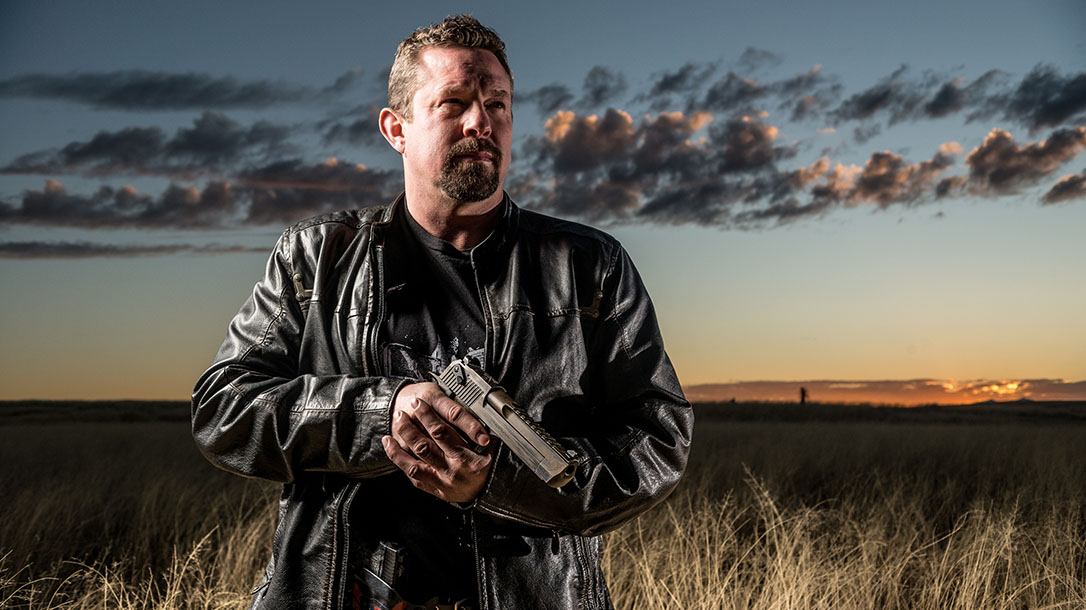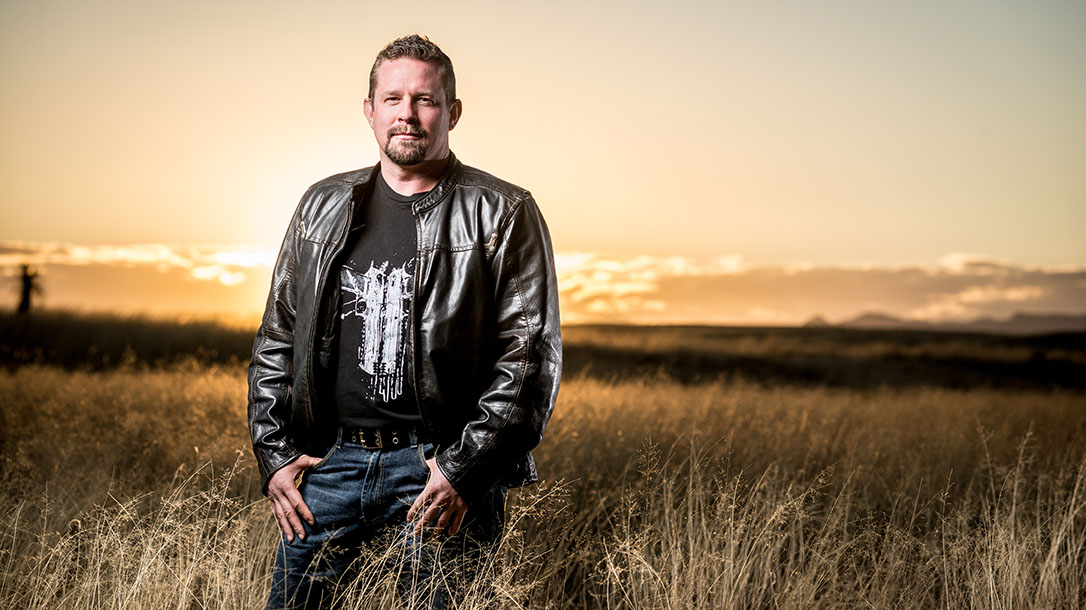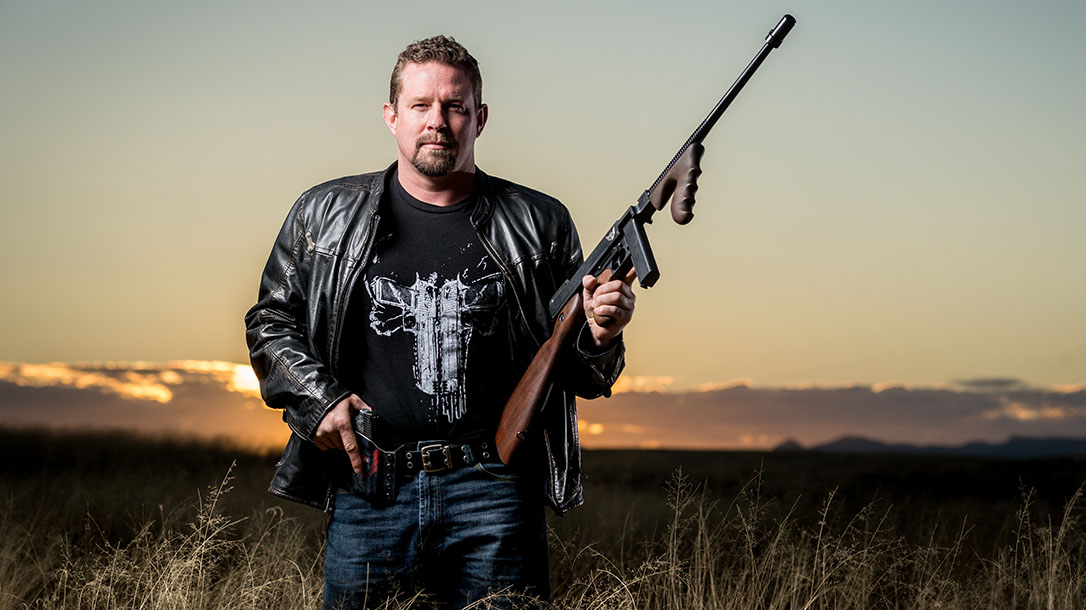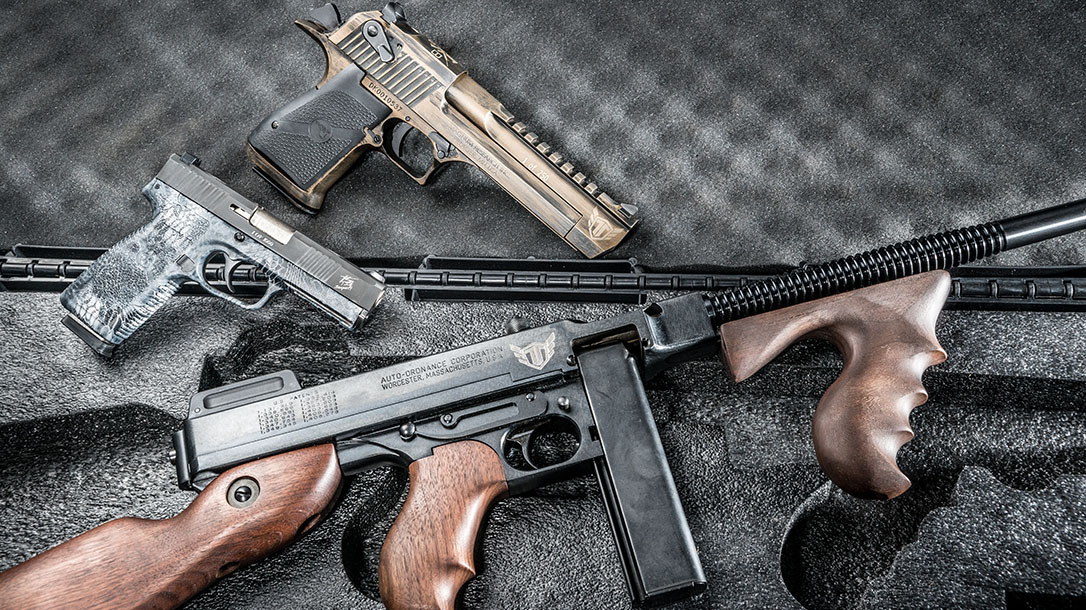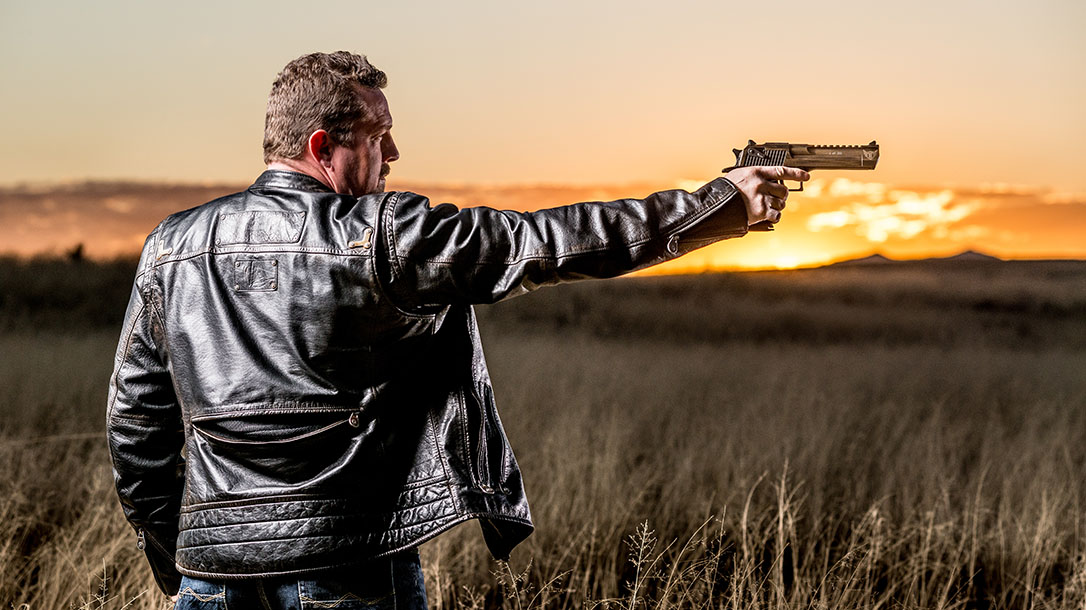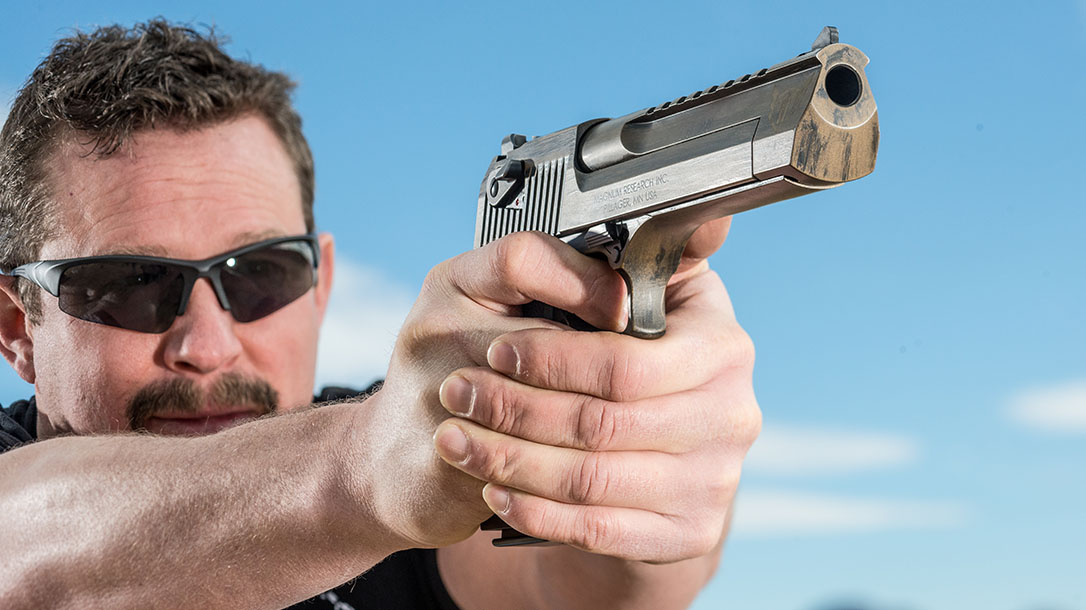John Tiegen, better known as “Tig,” is a veteran Marine who spent 10 years as a military contractor after leaving the Corps.
On September 11, 2012, Tig and the rest of his Global Response Staff (GRS) disobeyed orders, left the CIA annex and attempted to rescue American Ambassador Christopher Stevens and information officer Sean Smith at a U.S. diplomatic compound in Benghazi, Libya. His actions earned him the Award for Heroism and Valor. Later, Tiegen co-authored the book 13 Hours: The Inside Account of What Really Happened in Benghazi and was a consultant on the movie 13 Hours.
Advertisement — Continue Reading Below
The married father of twins recently flew to Tucson, Ariz., for this Ballistic interview and a chance to shoot and talk about Kahr Arms’ new special-edition “Tig” series guns, from which a portion of the proceeds will benefit his charity, Beyond the Battlefield: The Tiegen Foundation.
Special Editions
We found a secluded shooting spot at the historic Empire Ranch, southeast of Tucson, and set up some steel targets. Jodi DePorter, Kahr’s director of marketing, brought the new Tig-series Thompson, which Tig had not yet fired.
Advertisement — Continue Reading Below
A replica of the famous M1928 Thompson submachine gun, this semi-auto carbine is chambered in .45 ACP, just like the original but fires from a closed bolt. The gun has a 16.5-inch barrel with the distinctive Cutts compensator as well as a walnut vertical foregrip and buttstock. Tig’s edition is limited to just 1,000 units and has his Beyond the Battlefield logo, signature and personal logo engraved on the gun.
During our shooting session, we used 20-round box magazines, though the gun can accept optional 50- and 100-round drum magazines. With our steel target set at about 25 yards, Tig made the steel ring with every shot, laying rounds on top of each other. After unleashing 20 rounds on the target, he said, “That’s so much fun.”
Kahr introduced its new ST9 pistol at the 2017 NRA Annual Meetings in Atlanta, Georgia. Featuring a 4-inch barrel and chambered in 9mm, the pistol also features Kahr’s patented striker-fired control system, an accessory rail on the dust cover and forward cocking serrations. Its trim dimensions and light weight make it ideal for concealed carry. Well, Kahr decided to create Tig versions of these guns, and only 1,000 units will be made.
Advertisement — Continue Reading Below
The Tig-series ST9 features a stainless steel slide with a Black Armor Cerakote finish. Like the Tommy gun, Tig’s signature, charity and personal logo are laser-engraved onto the slide. The polymer frame is finished with Kryptek’s stylish Typhon camo pattern. (Tig carries his ST9 in a custom Full Metal Beard Kydex holster bearing his personal logo and uses the pistol for 3-Gun competition. He is deadly accurate with it.)
Kahr also owns Magnum Research, and its contribution to the Tiegen trio is the mighty Desert Eagle in .50 AE. Although most people are overwhelmed by the Desert Eagle’s size and weight, Tig carries it like any other handgun. Boasting a battle-worn bronze finish, the pistol also has Tig’s signature, personal logo and that of his charity. Only 250 of these customized Desert Eagles will be made.
During our range session, Tig probably fired more than 100 rounds while our photographer, Alex Landeen, took pictures and video of him shooting it. It was only afterward that Tig revealed he was scheduled for elbow surgery, and that the .50 AE rounds were beating him up. You would have never known it by the way he rang the steel.
Advertisement — Continue Reading Below
After collecting our brass, we made the brief drive to Mexico for lunch. Driving through the old Arizona towns of Sonoita and Patagonia on our way to the border at Nogales made for a scenic drive and game me some time to ask Tig some questions.
So, tell us about the Marines Corps. Why them and not another branch?
Watching Full Metal Jacket got me interested in joining the Marines. I was 18 when I joined. The recruiter called me during my third-period English class. Me and this teacher never got along, anyway. I think I was the only kid in school with a cell phone at that time, and the teacher was yelling at me.
Advertisement — Continue Reading Below
The recruiter asked me when I wanted to go to boot camp, and I said, “When do you need me?” He said next week. I hung up, got up and left. That was the end of high school for me.
I went to boot camp in San Diego, and my MOS was 0311 [marine rifleman]. I was an infantry squad leader. Four years later, I came out as an E5 [sergeant] and left the Corps with no combat experience.
I got married before I got out, and my wife was going into the Army, so I became a dependent. She got stationed up in Washington state, so I moved up there, and that’s when I got into heating and air conditioning.
Advertisement — Continue Reading Below
I did that for about four years. My wife got stationed in Kuwait, and the base where she was at had this company there doing all sorts of logistical contracting stuff. Before she came home, she got all of the contact info. We filled out all of the stuff and got accepted. I waited until I finished my HVAC degree in college, and in 2003, I started contracting for a company called Combat Support Associates.
When I was in Benghazi, I was with the agency [CIA] Global Response Staff. We are their personal security. I worked for them for a while and in contracting work for 10 years total.
We know about Benghazi, but where else did you do contract work?
When I was with Blackwater, I worked in most of the ’Stans. I did some work in Iraq, but most of my time was in Afghanistan.
Advertisement — Continue Reading Below
Compared to life in the Marine Corps, how was it in the world of contract work?
Oh, way better—a lot more fun. That’s one thing about the military: It can take the most fun thing and make it miserable. They could take a hotdog eating contest and turn it into something horrible. That’s just the military.
Our best time was actually in Libya. We’d have people shake our hands and tell us it is an honor to meet an American. They’d say, “Glad you guys are here and helping us.” Most of the people were happy to have us there. Sometimes in a restaurant or coffee shop, the locals would buy our food for us. It was totally different than anywhere I’ve ever been.
Who attacked the consulate?
A group known as Ansar al-Sharia. They are affiliated with Al-Qaeda, and I now know that they are associated with ISIS.
Advertisement — Continue Reading Below
When did you guys first realize there was a problem?
When we got the phone call. It was 23 minutes from the time we got the call to the time we got over there. Our station chief told me to stand down. I got out of the car and put my two cents in it. We could actually see the consulate was on fire. We said, “Hey, we need to get over there. We’re losing the initiative.” The chief of base operations said to stand down because we needed to come up with a plan. I told him it was too late. We needed to get eyes on and come up with a plan on the move. The final straw was when the State guy got on the radio and said, “If you don’t get here now, we’re all going to [expletive] die. We need your help now.”
How many of you went to the consulate?
There was a total of five of us, plus an interpreter and team leader. The team leader and linguist didn’t do a whole lot. I mean, they were communicating with the militia that we ran into at the corner, but there were only three of us that ran into the compound initially. We were probably in the compound by ourselves for a good five to 10 minutes.
Was the compound full of bad guys?
When we got there, I grabbed the grenade launcher and walked up to the corner and shot three rounds. The video feed showed that when those rounds hit, they took off running as fast as they could.
Of course, we didn’t know that. There was a huge breakdown in communications between us and the State Department. They had real-time video, and they should have been telling us what they were seeing. If they had told us that all the guys took off when I lobbed the grenades at them, we could have just jumped in our vehicles and drove down to the consulate. By the time we got there, it probably took us a good 30 minutes to get into the compound.
From what we know now, the ambassador was probably already dead.
Oh yeah. We found Sean Smith, the information officer, within a minute or two of entering the compound, and he was already dead. We had to repel one assault while we were at the consulate. Then we went back to our compound.
By the time you got back to the CIA annex, you were already injured?
Yeah, but I didn’t feel it. I didn’t feel it until the friggin’ next morning. I was going through the window, and I forgot I had my night-vision goggles up, and went in full force searching for the ambassador and ended up with bad whiplash.
Also, I got lung damage from smoke inhalation there at the consulate, and it still manifests itself as a dry cough. I got nerve damage in my elbow and will have some surgery soon to help with that.
How many hours were you up there on that rooftop?
I was in the towers from about 11:30 p.m. until the mortars came in at 5:30 in the morning; about six hours. I was crouched the whole time because you couldn’t stand straight up—the wall was waist high—and I’d be silhouetting myself. And I couldn’t sit in a chair because the chair was too low to see over the wall. I used an M4 on the tower.
Any idea of the number of attackers at the compound?
Twenty to 30 guys attacked the compound at a time—maybe 100 times all together.
When did you feel relief, like maybe this whole thing was finally over?
It wasn’t until after we got to the airport, when our plane took off.
How long did it take you to decompress from this incident?
Pretty much as soon as I got out of there and took a shower. I’d been doing this for 10 years and saw a lot of stuff. This wasn’t my first firefight but probably the longest.
How many rounds you think you fired that night?
Ah, not very many. I don’t spray and pray — I pick a target and shoot at it. I think I used fewer than four mags.
Was that your last job as a contractor?
No, I went back two more times. I had to wait because my lungs had to heal. I don’t think I went back to work until February or March following the attack, and it wasn’t in Libya.
When did you realize this was a huge story?
We knew it was going to be a big story that day, but we didn’t realize they would lie about it with the protest nonsense.
How did the book come about?
It was really “Oz” and “Tanto” [Mark Geist and Kris Paronto] who said we should write a book. We were getting kind of irritated with everything being said. There were rumors about the ambassador being captured and raped and everything, and that never happened. We went and testified. Yet they kept changing the story about how it happened. We were like, screw you. This is going to be part of American history. I was still contracting and was like, I really don’t know—maybe, as long as we do it the right way. Oz and Tanto went and met with the CIA, and they were kind of like, well, as long as you do it through the proper channels.
It was late 2013 when we decided to do it, and the book came out in September 2014, two years after the attack. The movie was pretty much guaranteed when we started with the book. Of course, we didn’t make any money off of it—the book or the movie. They keep saying they didn’t sell enough books and the movie didn’t do well enough. We got some up-front money, but everyone else made more money than we did. I would have made way more money if I’d just continued to contract.
Will you go back to contracting?
No, there’s no way I could, especially with the agency. I’m not going to go risk my life to protect an oil field or an executive. To me, it’s just not worth it.
How do you support yourself now?
Speaking events. That’s pretty much it. Companies like Kahr Arms, Riton Optics and Grunt Style sponsor me.
How do you spend most of your time now?
Traveling. I’ve also been trying to get into 3-Gun competition. I’ve also linked up with a retired detective out of Fort Worth teaching women situational awareness, self-defense and concealed carry. We’re only dealing with women—no men. Women are the ones who need more protection because they’re getting attacked more. The name of the company is Armed & Empowered. We just started it and have only had two classes. We’re both certified, so we can also give them a concealed-carry license as well. We’re trying to keep costs down so more people can afford to take the course.
What is your charity all about?
We’re trying to help guys with PTS—not PTSD, because it is not a “disorder.” Sometimes, we help get service dogs for them and financial help when they need it. We like to bring veterans and their families out and let them have a nice weekend. I actually grew up around bikers, and we loved to have a hog roast, come together and have fun. Now that I have some property, we do them at my place. We had a veteran who needed $5,000 to go to New York to have brain surgery because the VA wasn’t covering it. We ended up raising $2,500 for him.
During that time, we had a few other veterans come out. One guy brought his wife out, and he had two little girls. Two weeks after the hog roast, he emailed us and said that was going to be his last little hoorah, and then he was going to kill himself. But after being around the other veterans and talking to them, he realized he wasn’t alone in his feelings. After that, he didn’t feel so bad about things anymore.
Dana Bowman, who lost both his legs in a jump accident while an Army Golden Knight, jumped into our hog roast. This year, we’re going to try to take them all whitewater rafting. Eventually, I want to make it so it’s a weeklong event. Obviously, we pay for everything, and if they take time off from work, we’d like to be able to offset some of that cost.
If someone wants to know more about your charity, where can we send them?
My website is TheTiegenFoundation.org. You can go there, look around and see what we do. There are lots of pictures of our different events, and if you think what we’re doing is worthwhile, please consider making a donation.
When you want to do something for yourself, what do you do?
I ride my Harley Ultra Classic—that’s my getaway. Sometimes, I like to just go out and shoot—plink away. Play with my kids.
As a father of two, what would be your solution to keeping kids safe at school?
You should have the ability to lock a school down and have a pass system to get in. You could also have armed police officers. We saw what happened in Parkland, and what we need are individuals willing to risk their own lives to go save somebody and not just be a pretty boy at the front door. I believe in arming teachers. Take down the stupid “gun-free zone” signs and put up a sign that says every frickin’ teacher in this school is armed. It’s just another deterrent. Why put up a sign that says there are no guns here? You’re just inviting criminals.
Why is it so important for us to fight for our Second Amendment rights?
If we give them an inch, they’re going to take a mile. But I don’t think we need to give them anything. It says right there in the Constitution that it “shall not be infringed,” and it includes the militia and the people. For them to infringe on anybody’s rights to own firearms is against the Constitution.
What do you think about the high schoolers being used to push an anti-gun agenda?
If I could send those kids a message, it would be to learn some history and why our forefathers put the Second Amendment in the Constitution.
Have you had any threats regarding the Benghazi incident?
We did when the movie was coming out. Since then, it’s been pretty quiet.
If John Tiegen had a message to send to someone who was thinking of hurting you or your family, what would it be?
Better not miss.
For more information on Tig, please visit TheTiegenFoundation.org.
This article is from the summer 2018 issue of Ballistic Magazine. Grab your copy at OutdoorGroupStore.com.
